Abstract
1. Three monkeys were trained to perform a reaction-time task of the wrist and single-cell recordings were made from the motor cortex (eighty-four cells), ventro-posterior lateralis par caudalis (VPLc) (forty-two cells) and cerebellar thalamus (seventy-seven cells). 2. The majority (43/77, 56%) of cerebellar thalamic neurones fired phasically during movement, whereas in the motor cortex most neurones (53/84, 64%) had a phasic-tonic discharge pattern. Most neurones in both locations discharged in relation to the direction of movement (reciprocal pattern). 3. The cerebellar thalamus is unlike the motor cortex in that it does not usually encode a signal for force or joint position in its discharge. 4. Twenty-two per cent (17/77) of cerebellar thalamic neurones had a period of reduced discharge rate before the phasic burst of activity, and represent a pattern of discharge not seen in motor cortex or VPLc neurones. 5. The onset of phasic activity in the cerebellar thalamus was significantly later (average 94 ms) than in the motor cortex but occurred just before electromyogram (EMG) activity. The phasic activity in the cerebellar thalamus usually ended before the phasic component of motor cortex discharge was completed. 6. Phasic activity in VPLc neurones commenced after the onset of EMG discharge and on average 26 ms after the commencement of movement. Most neurones with deep sensory receptive fields fired with a reciprocal pattern, while neurones with cutaneous fields usually fixed bidirectionally in relation to the task. Almost one-third of neurones signalled force and a similar number had discharge levels that encoded characteristics of the joint position. 7. The duration of discharge of VPLc neurones during the voluntary movement was marginally less than the duration of the movement velocity peak and the VPLc may therefore be signalling the duration of the velocity. Phasic activity in cerebellar thalamic neurones fired for a duration similar to the VPLc neurones, but commenced before the movement. Therefore, if the cerebellar thalamus is carrying information about the duration of the velocity, it does so before the movement starts. 8. The phasic burst of activity in cells of the cerebellar thalamus is timed so that it can contribute to the later component of the phasic burst of motor cortical discharge. Thus we speculate that in skilled, ballistic movements, the cerebellum may provide a response which travels via the cerebellar thalamus and helps to determine the magnitude and duration of the phasic part of cortical discharge.(ABSTRACT TRUNCATED AT 400 WORDS)
Full text
PDF
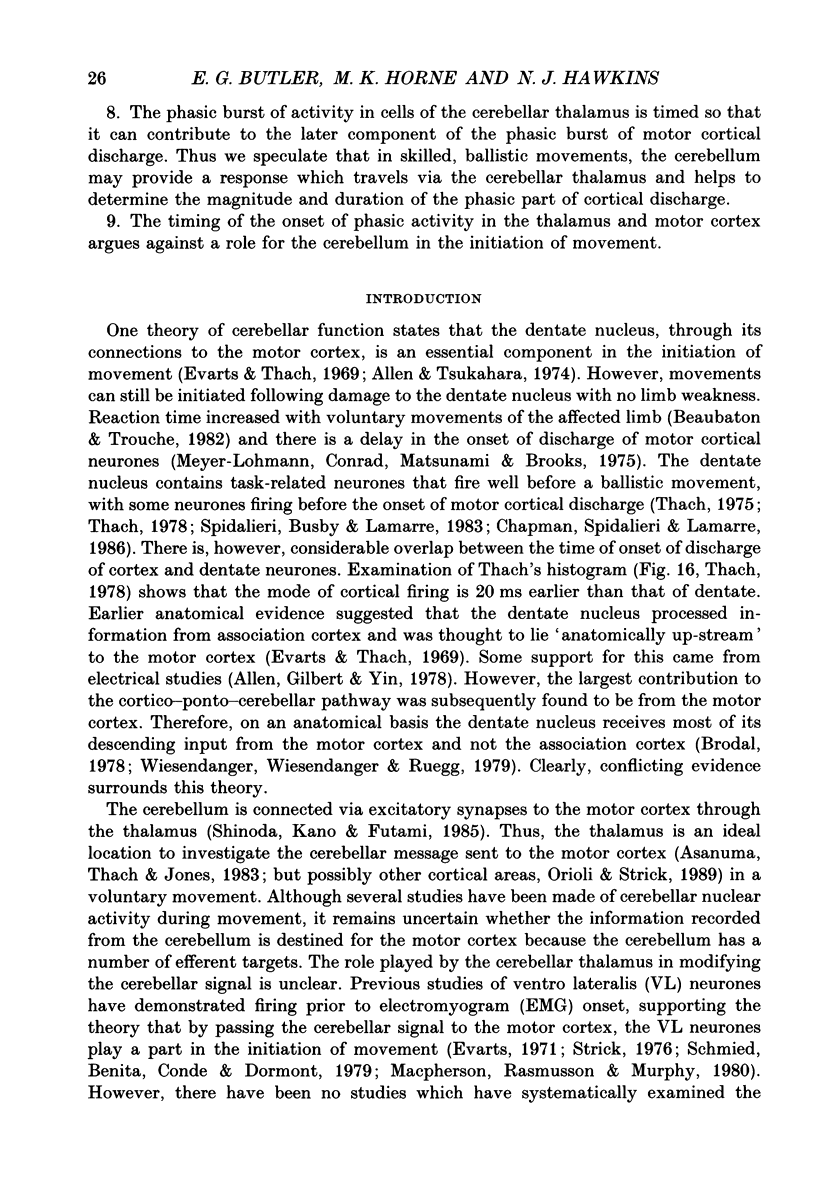
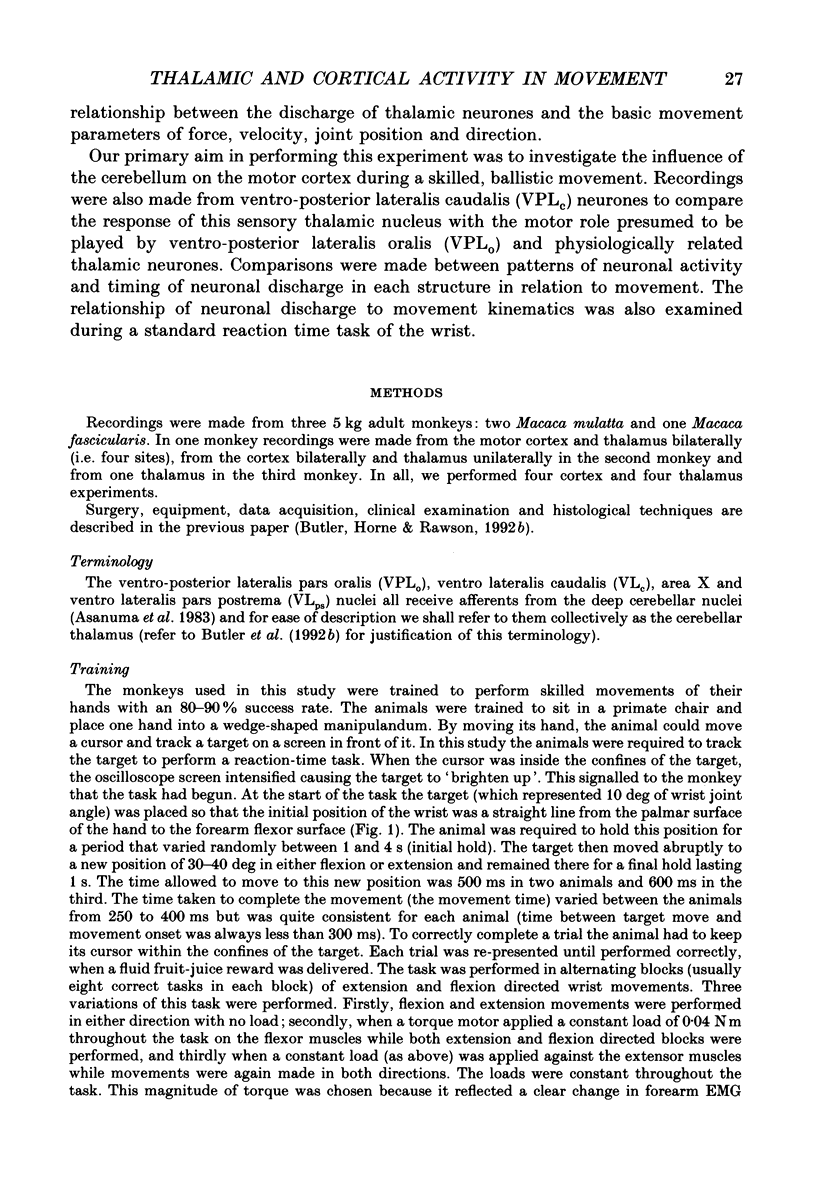

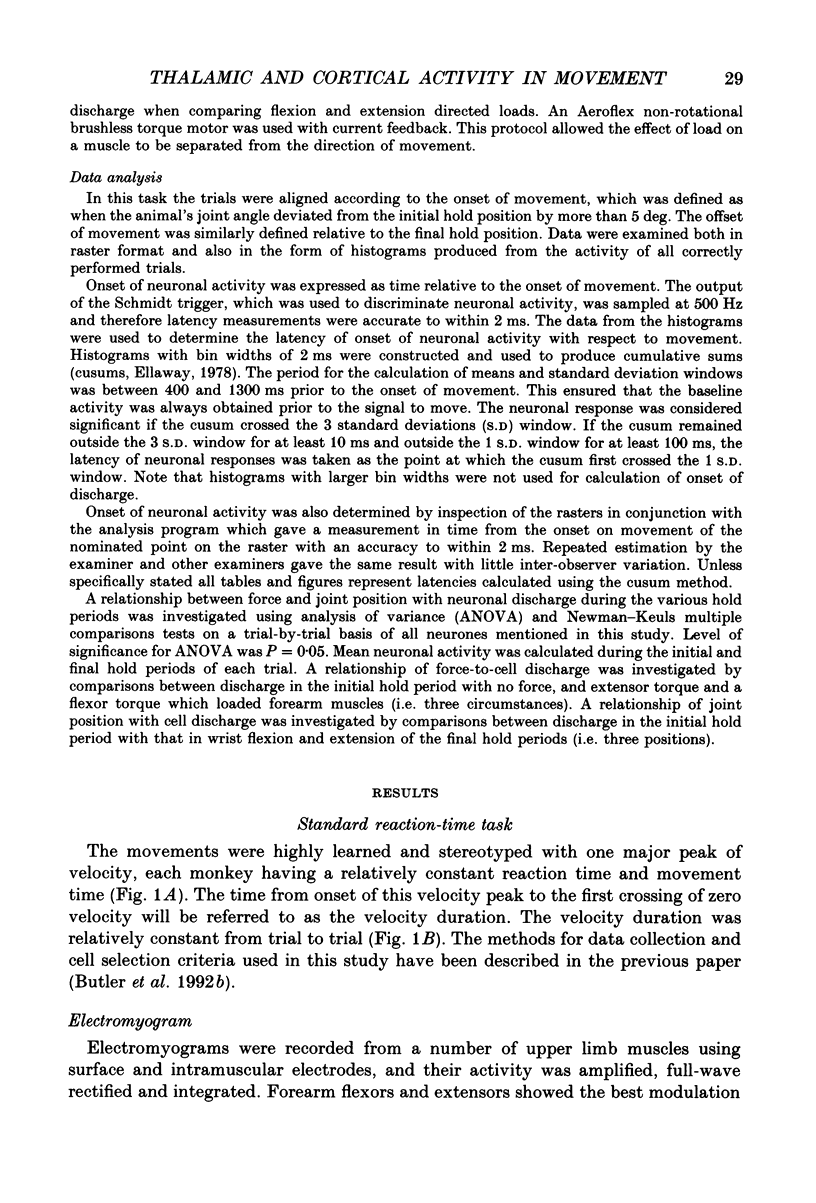






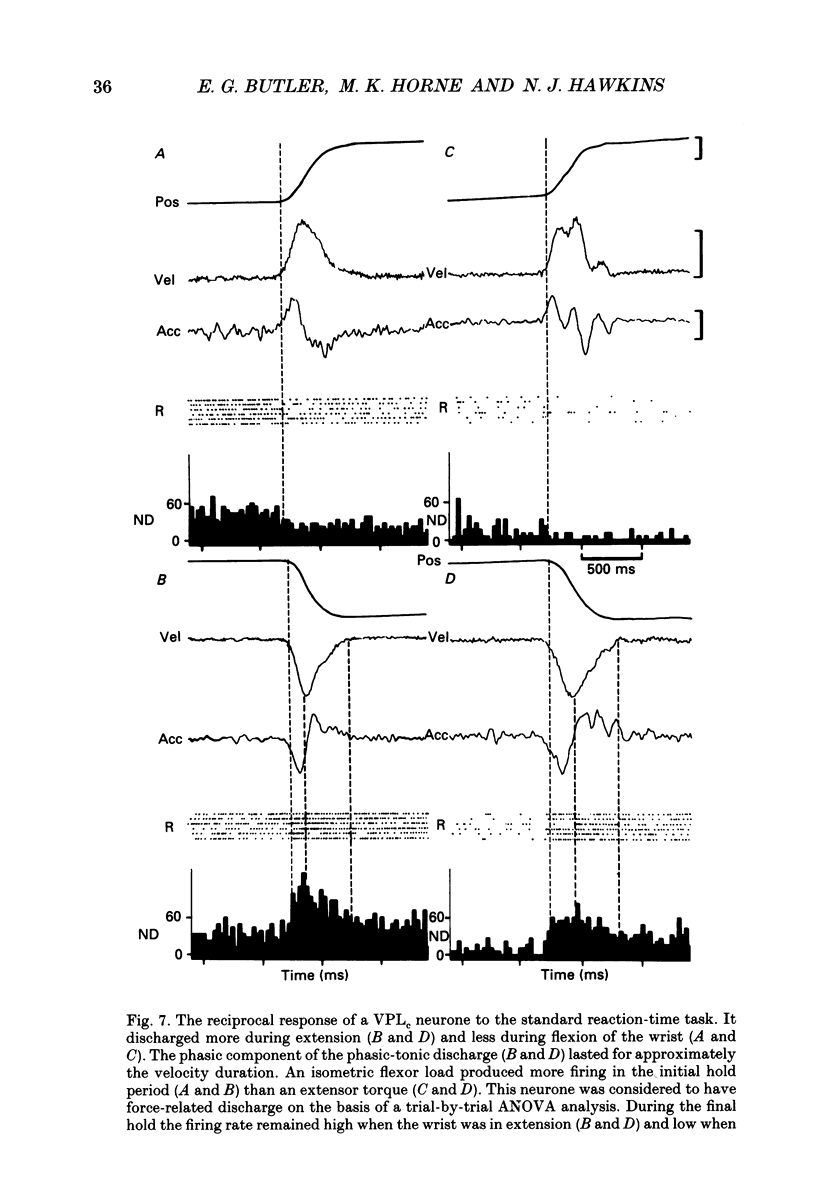
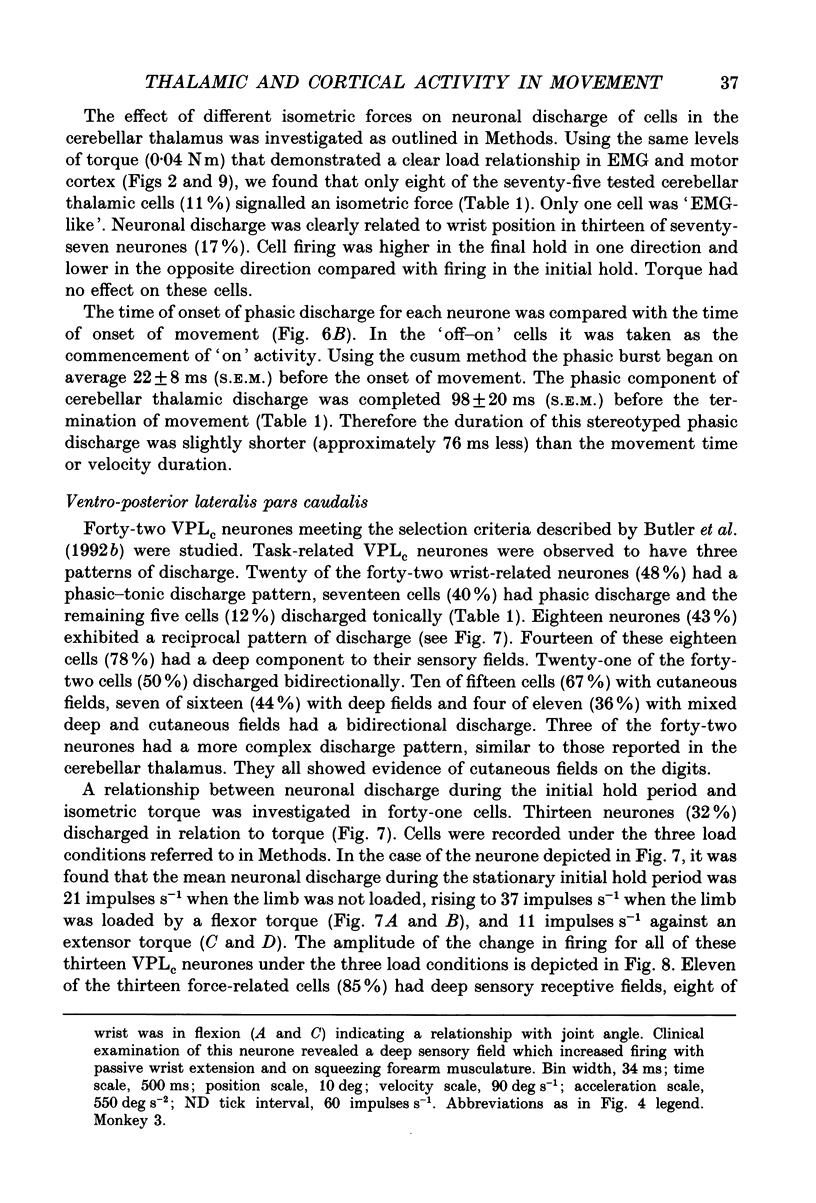



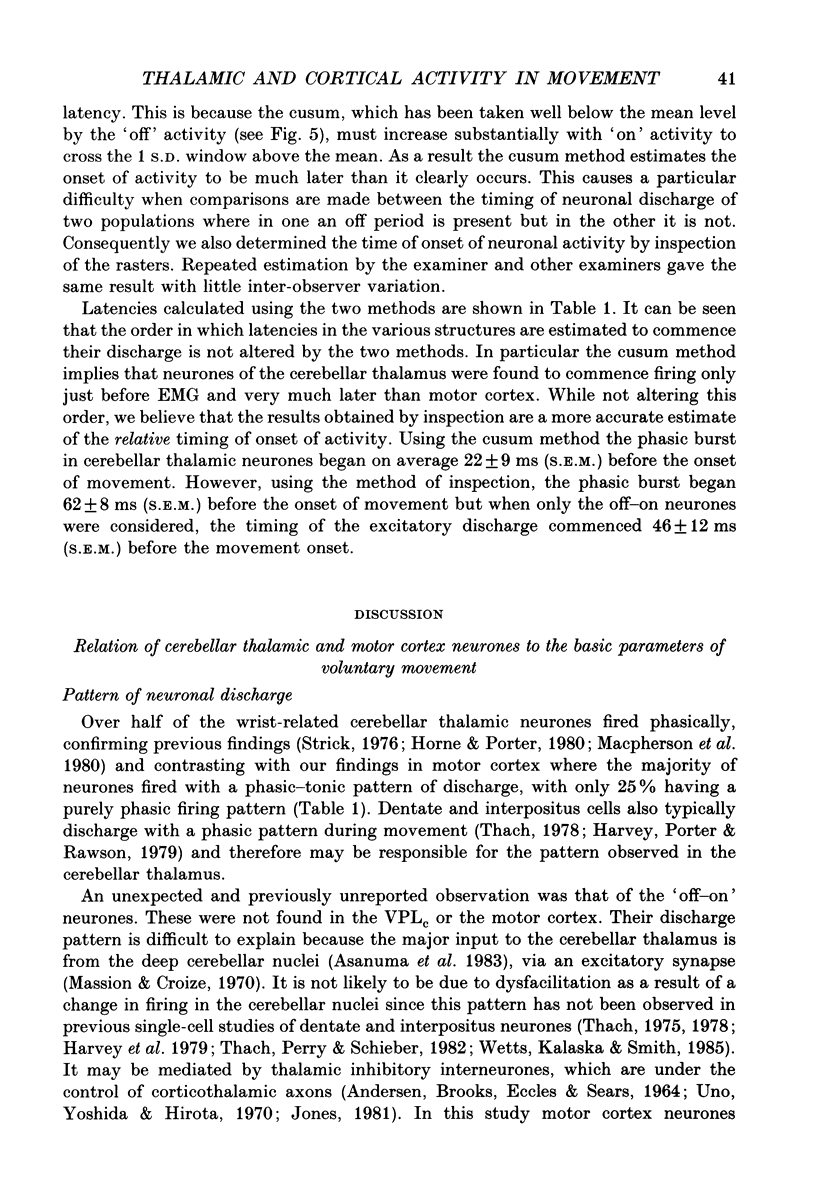



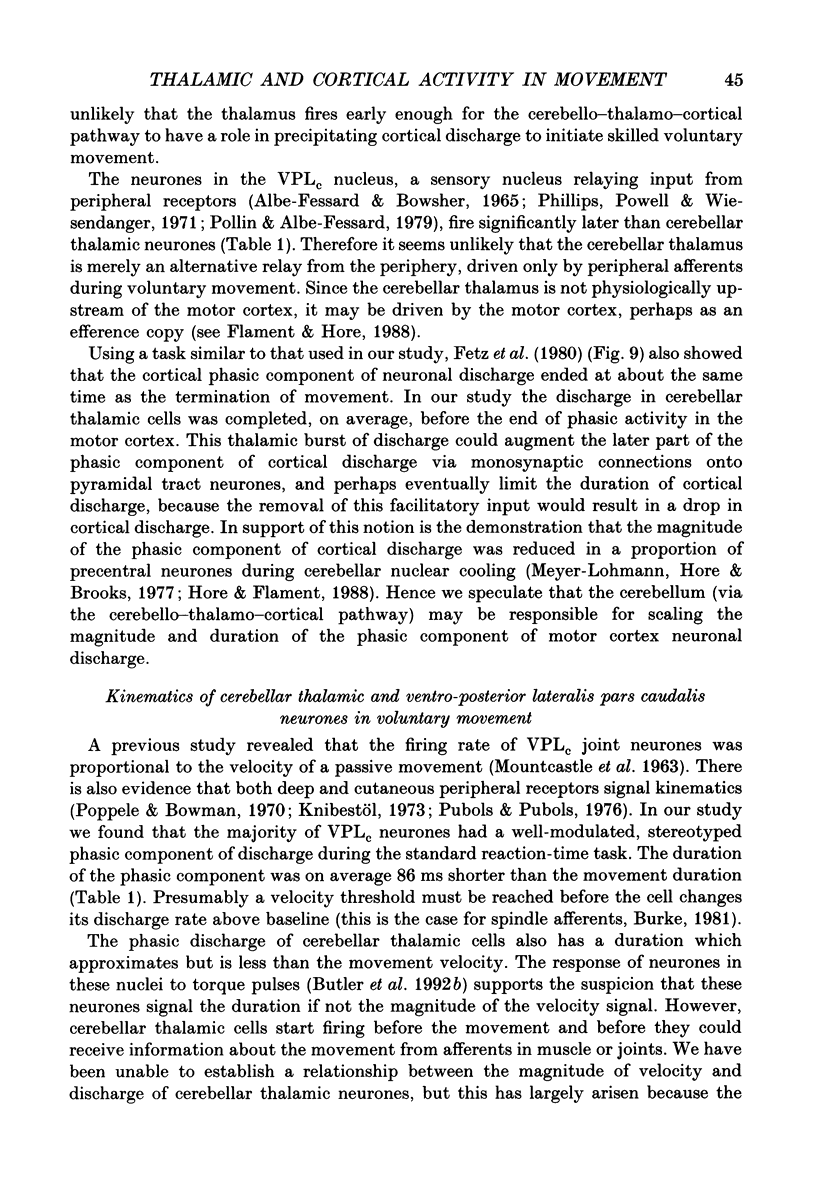

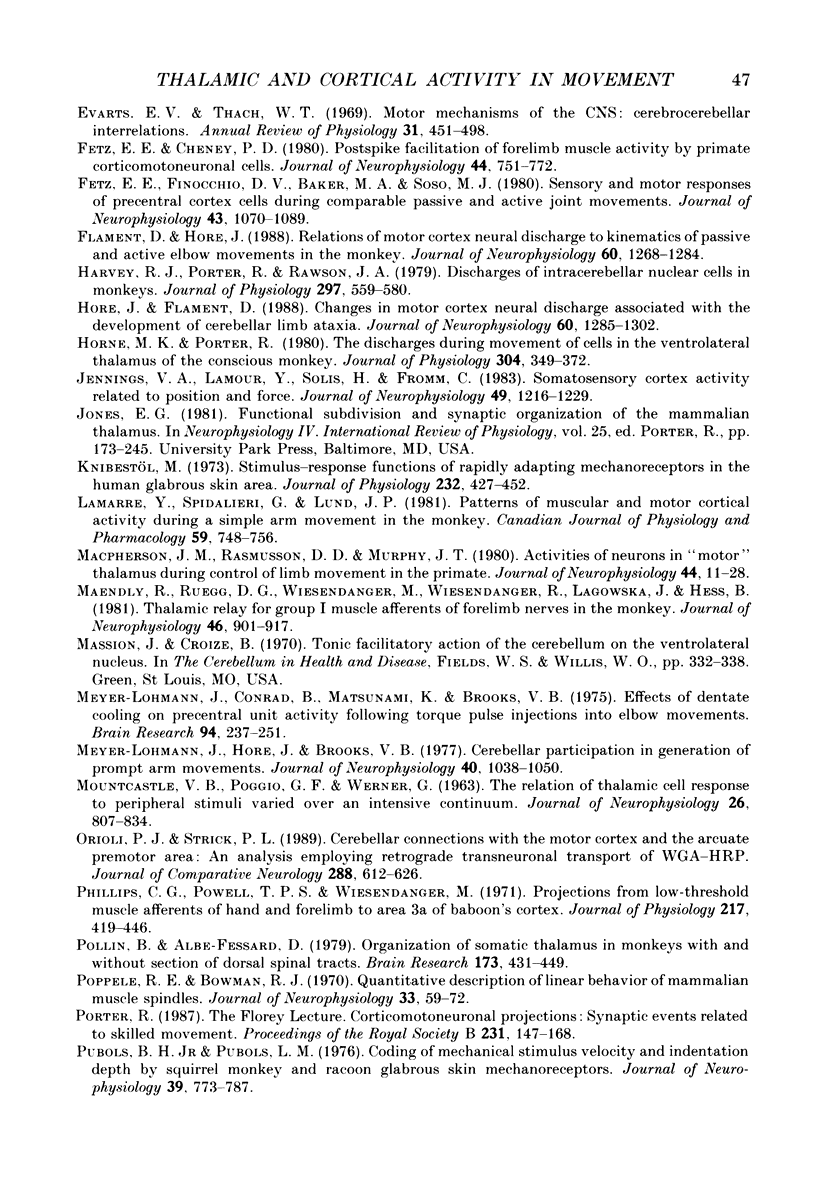

Selected References
These references are in PubMed. This may not be the complete list of references from this article.
- ALBE-FESSARD D., BOWSHER D. RESPONSES OF MONKEY THALAMUS TO SOMATIC STIMULI UNDER CHLORALOSE ANAESTHESIA. Electroencephalogr Clin Neurophysiol. 1965 Jul;19:1–15. doi: 10.1016/0013-4694(65)90002-7. [DOI] [PubMed] [Google Scholar]
- ANDERSEN P., BROOKS C. M., ECCLES J. C., SEARS T. A. THE VENTRO-BASAL NUCLEUS OF THE THALAMUS: POTENTIAL FIELDS, SYNAPTIC TRANSMISSION AND EXCITABILITY OF BOTH PRESYNAPTIC AND POST-SYNAPTIC COMPONENTS. J Physiol. 1964 Nov;174:348–369. doi: 10.1113/jphysiol.1964.sp007492. [DOI] [PMC free article] [PubMed] [Google Scholar]
- Allen G. I., Gilbert P. F., Yin T. C. Convergence of cerebral inputs onto dentate neurons in monkey. Exp Brain Res. 1978 Jun 19;32(2):151–170. doi: 10.1007/BF00239724. [DOI] [PubMed] [Google Scholar]
- Allen G. I., Tsukahara N. Cerebrocerebellar communication systems. Physiol Rev. 1974 Oct;54(4):957–1006. doi: 10.1152/physrev.1974.54.4.957. [DOI] [PubMed] [Google Scholar]
- Andersson S. A., Landgren S., Wolsk D. The thalamic relay and cortical projection of group I muscle afferents from the forelimb of the cat. J Physiol. 1966 Apr;183(3):576–591. doi: 10.1113/jphysiol.1966.sp007885. [DOI] [PMC free article] [PubMed] [Google Scholar]
- Anner-Baratti R., Allum J. H., Hepp-Reymond M. C. Neural correlates of isometric force in the "motor" thalamus. Exp Brain Res. 1986;63(3):567–580. doi: 10.1007/BF00237479. [DOI] [PubMed] [Google Scholar]
- Asanuma C., Thach W. R., Jones E. G. Anatomical evidence for segregated focal groupings of efferent cells and their terminal ramifications in the cerebellothalamic pathway of the monkey. Brain Res. 1983 May;286(3):267–297. doi: 10.1016/0165-0173(83)90016-4. [DOI] [PubMed] [Google Scholar]
- Beaubaton D., Trouche E. Participation of the cerebellar dentate nucleus in the control of a goal-directed movement in monkeys. Effects of reversible or permanent dentate lesion on the duration and accuracy of a pointing response. Exp Brain Res. 1982;46(1):127–138. doi: 10.1007/BF00238106. [DOI] [PubMed] [Google Scholar]
- Brodal P. The corticopontine projection in the rhesus monkey. Origin and principles of organization. Brain. 1978 Jun;101(2):251–283. doi: 10.1093/brain/101.2.251. [DOI] [PubMed] [Google Scholar]
- Burke D. The activity of human muscle spindle endings in normal motor behavior. Int Rev Physiol. 1981;25:91–126. [PubMed] [Google Scholar]
- Butler E. G., Horne M. K., Churchward P. R. A frequency analysis of neuronal activity in monkey thalamus, motor cortex and electromyograms in wrist oscillations. J Physiol. 1992 Jan;445:49–68. doi: 10.1113/jphysiol.1992.sp018911. [DOI] [PMC free article] [PubMed] [Google Scholar]
- Butler E. G., Horne M. K., Rawson J. A. Sensory characteristics of monkey thalamic and motor cortex neurones. J Physiol. 1992 Jan;445:1–24. doi: 10.1113/jphysiol.1992.sp018909. [DOI] [PMC free article] [PubMed] [Google Scholar]
- Chapman C. E., Spidalieri G., Lamarre Y. Activity of dentate neurons during arm movements triggered by visual, auditory, and somesthetic stimuli in the monkey. J Neurophysiol. 1986 Feb;55(2):203–226. doi: 10.1152/jn.1986.55.2.203. [DOI] [PubMed] [Google Scholar]
- Cheney P. D., Fetz E. E. Functional classes of primate corticomotoneuronal cells and their relation to active force. J Neurophysiol. 1980 Oct;44(4):773–791. doi: 10.1152/jn.1980.44.4.773. [DOI] [PubMed] [Google Scholar]
- Conrad B., Wiesendanger M., Matsunami K., Brooks V. B. Precentral unit activity related to control of arm movements. Exp Brain Res. 1977 Aug 8;29(1):85–95. doi: 10.1007/BF00236877. [DOI] [PubMed] [Google Scholar]
- Ellaway P. H. Cumulative sum technique and its application to the analysis of peristimulus time histograms. Electroencephalogr Clin Neurophysiol. 1978 Aug;45(2):302–304. doi: 10.1016/0013-4694(78)90017-2. [DOI] [PubMed] [Google Scholar]
- Evarts E. V. Activity of thalamic and cortical neurons in relation to learned movement in the monkey. Int J Neurol. 1971;8(2):321–326. [PubMed] [Google Scholar]
- Evarts E. V., Thach W. T. Motor mechanisms of the CNS: cerebrocerebellar interrelations. Annu Rev Physiol. 1969;31:451–498. doi: 10.1146/annurev.ph.31.030169.002315. [DOI] [PubMed] [Google Scholar]
- Fetz E. E., Cheney P. D. Postspike facilitation of forelimb muscle activity by primate corticomotoneuronal cells. J Neurophysiol. 1980 Oct;44(4):751–772. doi: 10.1152/jn.1980.44.4.751. [DOI] [PubMed] [Google Scholar]
- Fetz E. E., Finocchio D. V., Baker M. A., Soso M. J. Sensory and motor responses of precentral cortex cells during comparable passive and active joint movements. J Neurophysiol. 1980 Apr;43(4):1070–1089. doi: 10.1152/jn.1980.43.4.1070. [DOI] [PubMed] [Google Scholar]
- Flament D., Hore J. Relations of motor cortex neural discharge to kinematics of passive and active elbow movements in the monkey. J Neurophysiol. 1988 Oct;60(4):1268–1284. doi: 10.1152/jn.1988.60.4.1268. [DOI] [PubMed] [Google Scholar]
- Harvey R. J., Porter R., Rawson J. A. Discharges of intracerebellar nuclear cells in monkeys. J Physiol. 1979 Dec;297(0):559–580. doi: 10.1113/jphysiol.1979.sp013057. [DOI] [PMC free article] [PubMed] [Google Scholar]
- Hore J., Flament D. Changes in motor cortex neural discharge associated with the development of cerebellar limb ataxia. J Neurophysiol. 1988 Oct;60(4):1285–1302. doi: 10.1152/jn.1988.60.4.1285. [DOI] [PubMed] [Google Scholar]
- Horne M. K., Porter R. The discharges during movement of cells in the ventrolateral thalamus of the conscious monkey. J Physiol. 1980 Jul;304:349–372. doi: 10.1113/jphysiol.1980.sp013328. [DOI] [PMC free article] [PubMed] [Google Scholar]
- Jennings V. A., Lamour Y., Solis H., Fromm C. Somatosensory cortex activity related to position and force. J Neurophysiol. 1983 May;49(5):1216–1229. doi: 10.1152/jn.1983.49.5.1216. [DOI] [PubMed] [Google Scholar]
- Lamarre Y., Spidalieri G., Lund J. P. Patterns of muscular and motor cortical activity during a simple arm movement in the monkey. Can J Physiol Pharmacol. 1981 Jul;59(7):748–756. doi: 10.1139/y81-111. [DOI] [PubMed] [Google Scholar]
- MOUNTCASTLE V. B., POGGIO G. F., WERNER G. THE RELATION OF THALAMIC CELL RESPONSE TO PERIPHERAL STIMULI VARIED OVER AN INTENSIVE CONTINUUM. J Neurophysiol. 1963 Sep;26:807–834. doi: 10.1152/jn.1963.26.5.807. [DOI] [PubMed] [Google Scholar]
- Macpherson J. M., Rasmusson D. D., Murphy J. T. Activities of neurons in "motor" thalamus during control of limb movement in the primate. J Neurophysiol. 1980 Jul;44(1):11–28. doi: 10.1152/jn.1980.44.1.11. [DOI] [PubMed] [Google Scholar]
- Maendly R., Rüegg D. G., Wiesendanger M., Wiesendanger R., Lagowska J., Hess B. Thalamic relay for group I muscle afferents of forelimb nerves in the monkey. J Neurophysiol. 1981 Nov;46(5):901–917. doi: 10.1152/jn.1981.46.5.901. [DOI] [PubMed] [Google Scholar]
- Meyer-Lohmann J., Conrad B., Matsunami K., Brooks V. B. Effects of dentate cooling on precentral unit activity following torque pulse injections into elbow movements. Brain Res. 1975 Aug 29;94(2):237–251. doi: 10.1016/0006-8993(75)90059-1. [DOI] [PubMed] [Google Scholar]
- Meyer-Lohmann J., Hore J., Brooks V. B. Cerebellar participation in generation of prompt arm movements. J Neurophysiol. 1977 Sep;40(5):1038–1050. doi: 10.1152/jn.1977.40.5.1038. [DOI] [PubMed] [Google Scholar]
- Orioli P. J., Strick P. L. Cerebellar connections with the motor cortex and the arcuate premotor area: an analysis employing retrograde transneuronal transport of WGA-HRP. J Comp Neurol. 1989 Oct 22;288(4):612–626. doi: 10.1002/cne.902880408. [DOI] [PubMed] [Google Scholar]
- Phillips C. G., Powell T. P., Wiesendanger M. Projection from low-threshold muscle afferents of hand and forearm to area 3a of baboon's cortex. J Physiol. 1971 Sep;217(2):419–446. doi: 10.1113/jphysiol.1971.sp009579. [DOI] [PMC free article] [PubMed] [Google Scholar]
- Pollin B., Albe-Fessard D. Organization of somatic thalamus in monkeys with and without section of dorsal spinal tracts. Brain Res. 1979 Sep 21;173(3):431–449. doi: 10.1016/0006-8993(79)90240-3. [DOI] [PubMed] [Google Scholar]
- Poppele R. E., Bowman R. J. Quantitative description of linear behavior of mammalian muscle spindles. J Neurophysiol. 1970 Jan;33(1):59–72. doi: 10.1152/jn.1970.33.1.59. [DOI] [PubMed] [Google Scholar]
- Porter R. The Florey lecture, 1987. Corticomotoneuronal projections: synaptic events related to skilled movement. Proc R Soc Lond B Biol Sci. 1987 Jul 22;231(1263):147–168. doi: 10.1098/rspb.1987.0039. [DOI] [PubMed] [Google Scholar]
- Pubols B. H., Pubols L. M. Coding of mechanical stimulus velocity and indentation depth by squirrel monkey and raccoon glabrous skin mechanoreceptors. J Neurophysiol. 1976 Jul;39(4):773–787. doi: 10.1152/jn.1976.39.4.773. [DOI] [PubMed] [Google Scholar]
- Schieber M. H., Thach W. T., Jr Trained slow tracking. I. Muscular production of wrist movement. J Neurophysiol. 1985 Nov;54(5):1213–1227. doi: 10.1152/jn.1985.54.5.1213. [DOI] [PubMed] [Google Scholar]
- Schieber M. H., Thach W. T., Jr Trained slow tracking. II. Bidirectional discharge patterns of cerebellar nuclear, motor cortex, and spindle afferent neurons. J Neurophysiol. 1985 Nov;54(5):1228–1270. doi: 10.1152/jn.1985.54.5.1228. [DOI] [PubMed] [Google Scholar]
- Schmied A., Bénita M., Condé H., Dormont J. F. Activity of ventrolateral thalamic neurons in relation to a simple reaction time task in the cat. Exp Brain Res. 1979 Jul 2;36(2):285–300. doi: 10.1007/BF00238912. [DOI] [PubMed] [Google Scholar]
- Shinoda Y., Kano M., Futami T. Synaptic organization of the cerebello-thalamo-cerebral pathway in the cat. I. Projection of individual cerebellar nuclei to single pyramidal tract neurons in areas 4 and 6. Neurosci Res. 1985 Feb;2(3):133–156. doi: 10.1016/0168-0102(85)90009-4. [DOI] [PubMed] [Google Scholar]
- Soso M. J., Fetz E. E. Responses of identified cells in postcentral cortex of awake monkeys during comparable active and passive joint movements. J Neurophysiol. 1980 Apr;43(4):1090–1110. doi: 10.1152/jn.1980.43.4.1090. [DOI] [PubMed] [Google Scholar]
- Spidalieri G., Busby L., Lamarre Y. Fast ballistic arm movements triggered by visual, auditory, and somesthetic stimuli in the monkey. II. Effects of unilateral dentate lesion on discharge of precentral cortical neurons and reaction time. J Neurophysiol. 1983 Dec;50(6):1359–1379. doi: 10.1152/jn.1983.50.6.1359. [DOI] [PubMed] [Google Scholar]
- Strick P. L. Activity of ventrolateral thalamic neurons during arm movement. J Neurophysiol. 1976 Sep;39(5):1032–1044. doi: 10.1152/jn.1976.39.5.1032. [DOI] [PubMed] [Google Scholar]
- Thach W. T. Correlation of neural discharge with pattern and force of muscular activity, joint position, and direction of intended next movement in motor cortex and cerebellum. J Neurophysiol. 1978 May;41(3):654–676. doi: 10.1152/jn.1978.41.3.654. [DOI] [PubMed] [Google Scholar]
- Thach W. T. Timing of activity in cerebellar dentate nucleus and cerebral motor cortex during prompt volitional movement. Brain Res. 1975 May 2;88(2):233–241. doi: 10.1016/0006-8993(75)90387-x. [DOI] [PubMed] [Google Scholar]
- Tsumoto T. Characteristics of the thalamic ventrobasal relay neurons as a function of conduction velocities of medial lemniscal fibers. Exp Brain Res. 1974;21(2):211–224. doi: 10.1007/BF00234390. [DOI] [PubMed] [Google Scholar]
- Uno M., Yoshida M., Hirota I. The mode of cerebello-thalamic relay transmission investigated with intracellular recording from cells of the ventrolateral nucleus of cat's thalamus. Exp Brain Res. 1970;10(2):121–139. doi: 10.1007/BF00234726. [DOI] [PubMed] [Google Scholar]
- Vallbo A. B. Muscle spindle response at the onset of isometric voluntary contractions in man. Time difference between fusimotor and skeletomotor effects. J Physiol. 1971 Oct;218(2):405–431. doi: 10.1113/jphysiol.1971.sp009625. [DOI] [PMC free article] [PubMed] [Google Scholar]
- Wetts R., Kalaska J. F., Smith A. M. Cerebellar nuclear cell activity during antagonist cocontraction and reciprocal inhibition of forearm muscles. J Neurophysiol. 1985 Aug;54(2):231–244. doi: 10.1152/jn.1985.54.2.231. [DOI] [PubMed] [Google Scholar]
- Wiesendanger R., Wiesendanger M., Rüegg D. G. An anatomical investigation of the corticopontaine projection in the primate (Macaca fascicularis and Saimiri sciureus)--II. The projection from frontal and parental association areas. Neuroscience. 1979;4(6):747–765. doi: 10.1016/0306-4522(79)90004-6. [DOI] [PubMed] [Google Scholar]
- Yamamoto K., Odagiri M. Discharge pattern differences between cat interpositus and dentate neurons during isometric lever pressing. Exp Brain Res. 1981;43(1):104–106. doi: 10.1007/BF00238816. [DOI] [PubMed] [Google Scholar]


